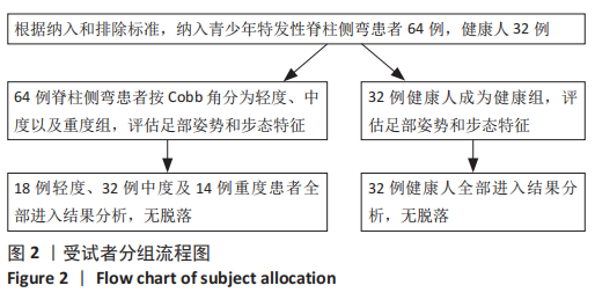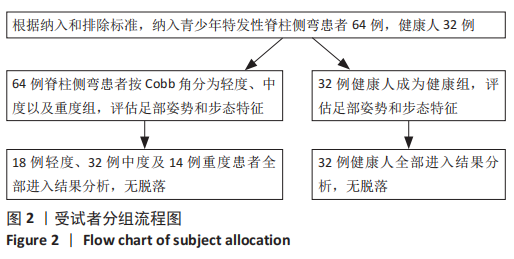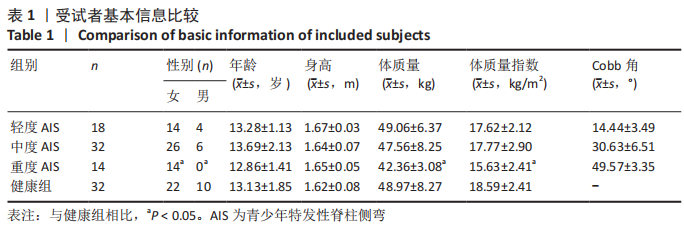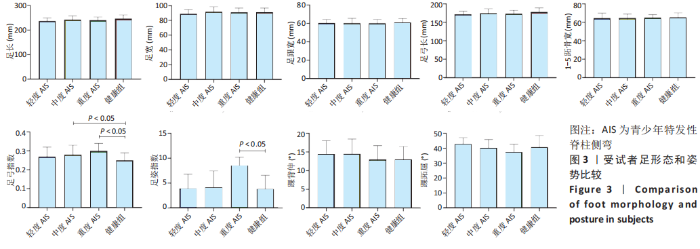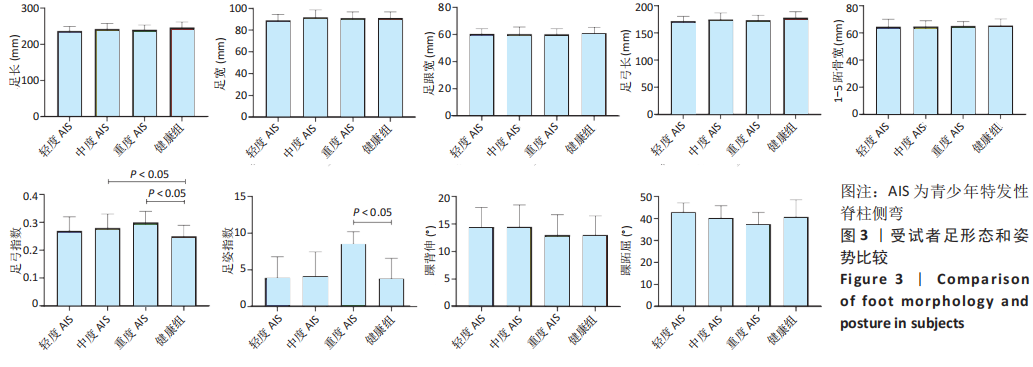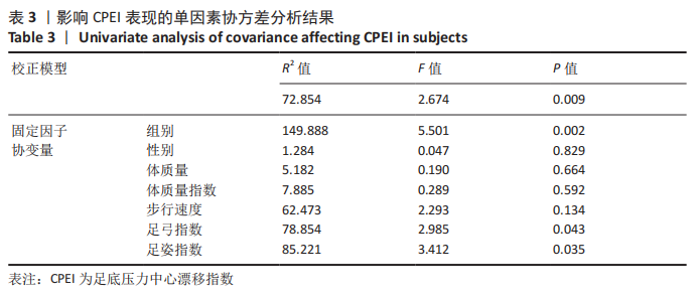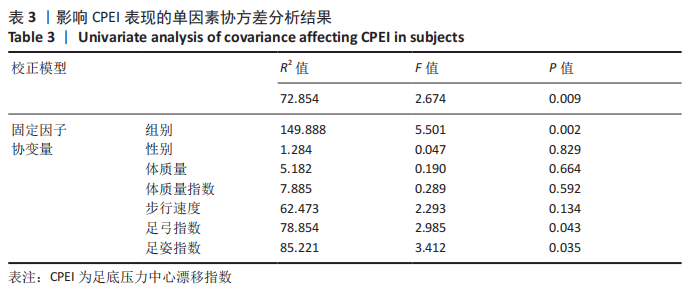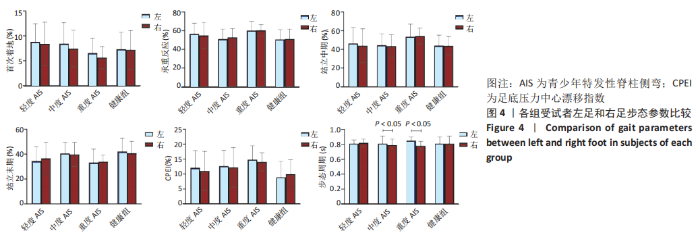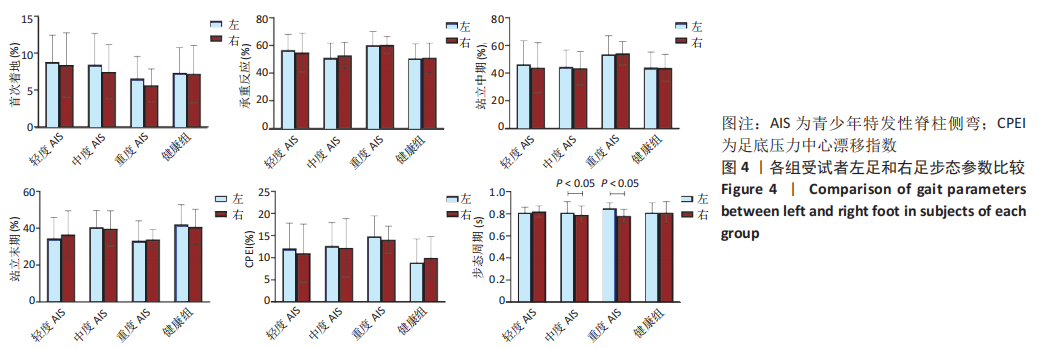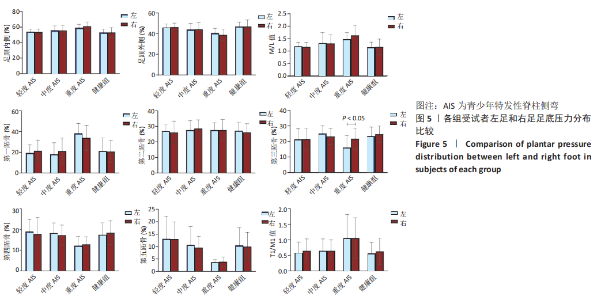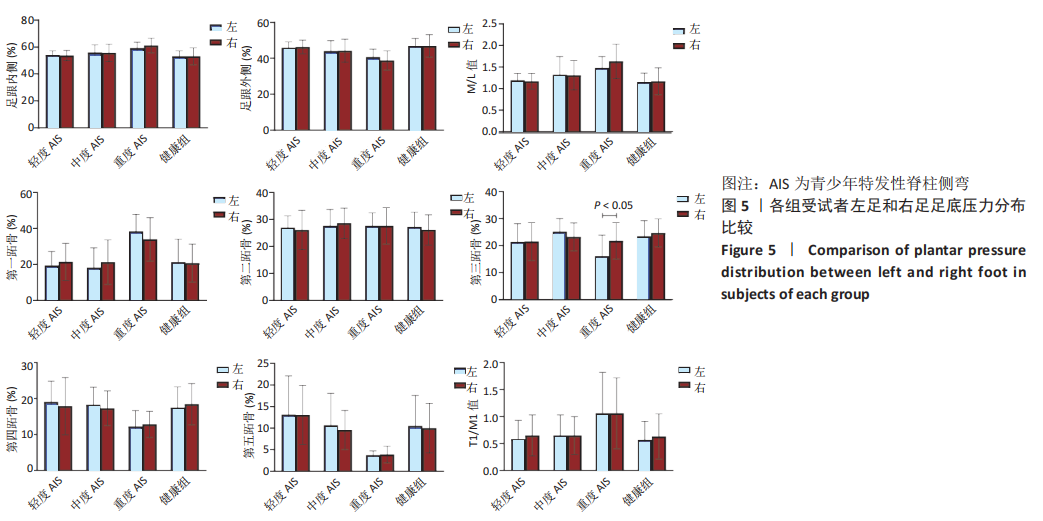Chinese Journal of Tissue Engineering Research ›› 2021, Vol. 25 ›› Issue (33): 5294-5300.doi: 10.12307/2021.316
Previous Articles Next Articles
Foot posture and gait in adolescent idiopathic scoliosis patients: three-dimensional morphological analysis and biomechanics evaluation
Zhu Feilong1, Zhang Ming1, 2, Wu Yu1, Wang Bin1, Guo Xiaoqi2, Cao Jiangang1, 2, Zhu Qian2, 3, Chen Wei1, 2
- 1Department of Rehabilitation, Affiliated Xuzhou Rehabilitation Hospital of Xuzhou Medical University, Xuzhou 221000, Jiangsu Province, China; 2Department of Rehabilitation Medicine of Xuzhou Central Hospital, Xuzhou 221009, Jiangsu Province, China; 3Xuzhou Taishan Community Health Service Center, Xuzhou 221003, Jiangsu Province, China
-
Received:2021-02-22Revised:2021-02-24Accepted:2021-03-24Online:2021-11-28Published:2021-08-03 -
Contact:Chen Wei, Master, Chief physician, Professor, Master’s supervisor, Department of Rehabilitation, Affiliated Xuzhou Rehabilitation Hospital of Xuzhou Medical University, Xuzhou 221000, Jiangsu Province, China; Department of Rehabilitation Medicine of Xuzhou Central Hospital, Xuzhou 221009, Jiangsu Province, China -
About author:Zhu Feilong, Master candidate, Junior technician, Department of Rehabilitation, Affiliated Xuzhou Rehabilitation Hospital of Xuzhou Medical University, Xuzhou 221000, Jiangsu Province, China -
Supported by:Jiangsu Provincial Medical Youth Talent Program, No. QNRC2016376 (to ZM)
CLC Number:
Cite this article
Zhu Feilong, Zhang Ming, Wu Yu, Wang Bin, Guo Xiaoqi, Cao Jiangang, Zhu Qian, Chen Wei. Foot posture and gait in adolescent idiopathic scoliosis patients: three-dimensional morphological analysis and biomechanics evaluation[J]. Chinese Journal of Tissue Engineering Research, 2021, 25(33): 5294-5300.
share this article
Add to citation manager EndNote|Reference Manager|ProCite|BibTeX|RefWorks

2.4 步态参数比较分析结果 由表2可知,与健康组相比,重度青少年特发性脊柱侧弯组承重反应期提前,站立末期延迟(P < 0.05),中和重度青少年特发性脊柱侧弯组行走速度较健康组减慢且足底压力中心漂移指数显著增加(P < 0.05)。单因素协方差分析结果显示,对性别、体质量、体质量指数、足姿指数、足弓指数和步行速度协变量调整之后,脊柱侧弯仍对受试者的步行表现造成显著影响(F=2.67,P=0.009),组别的回归贡献最高且有显著性意义(P < 0.05),其次为足弓指数和足姿指数,有显著性意义(P < 0.05),详见表3。受试者左足和右足进行组内比较时,结果显示中和重度青少年特发性脊柱侧弯组左足和右足步态周期不对称,存在显著性差异(P < 0.05),见图4。 "

| [1] ADDAI D, ZARKOS J, BOWEY AJ. Current concepts in the diagnosis and management of adolescent idiopathic scoliosis. Childs Nerv Syst. 2020;36(6):1111-1119. [2] PENG Y, WANG SR, QIU GX, et al. Research progress on the etiology and pathogenesis of adolescent idiopathic scoliosis. Chin Med J (Engl). 2020;133(4):483-493. [3] 陈梦婕,罗义,马琪超,等.青少年特发性脊柱侧弯的冠状位平衡与足底压力的相关性 [J].中华全科医学,2020,18(4):542-546. [4] KUZNIA AL, HERNANDEZ AK, LEE LU. Adolescent idiopathic scoliosis: common questions and answers. Am Fam Physician. 2020;101(1): 19-23. [5] WU KW, WANG TM, HU CC, et al. Postural adjustments in adolescent idiopathic thoracic scoliosis during walking. Gait Posture. 2019;68: 423-429. [6] 游国鹏,杜青,陈楠,等.青少年特发性脊柱侧凸患者步态运动学及足底压力特征分析[J].中华物理医学与康复杂志,2013,35(7): 537-541. [7] ZHANG H, GUO Y, ZANOTTO D. Accurate ambulatory gait analysis in walking and running using machine learning models. IEEE Trans Neural Syst Rehabil Eng. 2020;28(1):191-202. [8] 李省华,王连成,申慧圆.青少年特发性脊柱侧凸48例患者的静态平衡能力研究[J].医学综述,2019,25(14):2897-2902. [9] 成西侠,徐超,白建萍.青少年脊柱侧弯患者足底压力分析[J].当代临床医刊,2018,31(4):3925-3926. [10] 韩秀兰,许轶,李小金,等.青少年特发性脊柱侧弯症患者的足底压力差异分析及穿戴矫形鞋垫的影响[J].中山大学学报(医学科学版),2017,38(4):582-589. [11] 周璇,杜青,赵黎,等.青少年特发性脊柱侧凸患者的静态平衡功能研究[J].中国康复医学杂志,2010,25(10):953-956. [12] MA Q, LIN H, WANG L, et al. Correlation between spinal coronal balance and static baropodometry in children with adolescent idiopathic scoliosis. Gait Posture. 2020;75:93-97. [13] CATAN L, CERBU S, AMARICAI E, et al. Assessment of static plantar pressure, stabilometry, vitamin d and bone mineral density in female adolescents with moderate idiopathic scoliosis. Int J Environ Res Public Health. 2020;17(6):2167. [14] WIERNICKA M, KOTWICKI T, KAMINSKA E, et al. Postural Stability in Adolescent Girls with Progressive Idiopathic Scoliosis. Biomed Res Int. 2019;2019:7103546. [15] KIM K, MULLINEAUX DR, JEON K. A comparative study of spinal deformity and plantar pressure according to the static standing posture of female adolescents with or without idiopathic scoliosis. Iran J Public Health. 2019;48(2):345-346. [16] LEE, JEONG UK. Comparison of dynamic plantar foot pressure in normal subjects and patients with adolescent idiopathic scoliosis for health science research. Toxicol Environ Health Ences. 2017;9(5):269-278. [17] DARYABOR A, ARAZPOUR M, SHARIFI G, et al. Gait and energy consumption in adolescent idiopathic scoliosis: a literature review. Ann Phys Rehabil Med. 2017;60(2):107-116. [18] LEE J, KIM M, KIM J. Comparison of static plantar foot pressure between healthy subjects and patients with adolescent idiopathic scoliosis. Toxicol Environ Health Sci. 2014;6(2):127-132. [19] CHERN JS, KAO CC, LAI PL, et al. Severity of spine malalignment on center of pressure progression during level walking in subjects with adolescent idiopathic scoliosis. Conf Proc IEEE Eng Med Biol Soc. 2014;2014:5888-5891. [20] YANG JH, SUH SW, SUNG PS, et al. Asymmetrical gait in adolescents with idiopathic scoliosis. Eur Spine J. 2013;22(11):2407-2413. [21] MAHAUDENS P, BANSE X, MOUSNY M, et al. Gait in adolescent idiopathic scoliosis: kinematics and electromyographic analysis. Eur Spine J. 2009;18(4):512-521. [22] KRAMERS-QUERVAIN IA, MULLER R, STACOFF A, et al. Gait analysis in patients with idiopathic scoliosis. Eur Spine J. 2004;13(5):449-456. [23] WOZNIACKA R, OLEKSY L, JANKOWICZ-SZYMANSKA A, et al. The association between high-arched feet, plantar pressure distribution and body posture in young women. Sci Rep. 2019;9(1):17187. [24] Horne JP, Flannery R, Usman S. Adolescent idiopathic scoliosis: diagnosis and management. Am Fam Physician. 2014;89(3):193-198. [25] FORCE-USPST, GROSSMAN DC, CURRY SJ, et al. Screening for adolescent idiopathic scoliosis: US preventive services task force recommendation statement. JAMA. 2018;319(2):165-172. [26] ALTAF F, GIBSON A, DANNAWI Z, et al. Adolescent idiopathic scoliosis. BMJ. 2013;346:f2508. [27] CHO Y, PARK JW, NAM K. The relationship between foot posture index and resting calcaneal stance position in elementary school students. Gait Posture. 2019;74:142-147. [28] REDMOND AC, CRANE YZ, MENZ HB. Normative values for the Foot Posture Index. J Foot Ankle Res. 2008;1(1):6. [29] CAVANAGH PR, RODGERS MM. The arch index: a useful measure from footprints. J Biomech. 1987;20(5):547-551. [30] GIJON-NOGUERON G, MARCHENA-RODRIGUEZ A, MONTES-ALGUACIL J, et al. Evaluation of the paediatric foot using footprints and foot posture index: a cross-sectional study. J Paediatr Child Health. 2020;56(2): 201-206. [31] HABER CK, SACCO M. Scoliosis: lower limb asymmetries during the gait cycle. Arch Physiother. 2015;8(5):4. [32] YAZDANI S, FARAHPOUR N, HABIBI M, et al. Spatiotemporal Variables of Gait in Patients with Adolescent Idiopathic Scoliosis and Healthy Individuals. J Sport Biomech. 2016;2(3):5-14. [33] HAGEDORN TJ, DUFOUR AB, RISKOWSKI JL, et al. Foot disorders, foot posture, and foot function: the Framingham foot study. PLoS One. 2013;8(9):e74364. [34] BULDT AK, ALLAN JJ, LANDORF KB, et al. The relationship between foot posture and plantar pressure during walking in adults: a systematic review. Gait Posture. 2018;62:56-67. [35] HERONEMUS MJ, RABE K, TOLSTYKH I, et al. The association of parity with greater dynamic pronation of the feet. PM R. 2021;13(2):144-152. [36] JANDOVA S, GAJDOS M, URBANOVA K, et al. Temporal and dynamic changes in plantar pressure distribution, as well as in posture during slow walking in flat and high-heel shoes. Acta Bioeng Biomech. 2019; 21(4):131-138. [37] GIMUNOVA M, ZVONAR M, MIKESKA O. The effect of aging and gender on plantar pressure distribution during the gait in elderly. Acta Bioeng Biomech. 2018;20(4):139-144. (责任编辑:WJ,ZN,ZH) |
| [1] | Zhou Jihui, Li Xinzhi, Zhou You, Huang Wei, Chen Wenyao. Multiple problems in the selection of implants for patellar fracture [J]. Chinese Journal of Tissue Engineering Research, 2021, 25(9): 1440-1445. |
| [2] | Xu Feng, Kang Hui, Wei Tanjun, Xi Jintao. Biomechanical analysis of different fixation methods of pedicle screws for thoracolumbar fracture [J]. Chinese Journal of Tissue Engineering Research, 2021, 25(9): 1313-1317. |
| [3] | Chen Zehua, Ye Xiangling, Chen Weijian, Du Jianping, Liu Wengang, Xu Xuemeng. Effect of pronated foot posture on proprioception and postural stability based on foot posture index [J]. Chinese Journal of Tissue Engineering Research, 2021, 25(9): 1324-1328. |
| [4] | Lü Zhen, Bai Jinzhu. A prospective study on the application of staged lumbar motion chain rehabilitation based on McKenzie’s technique after lumbar percutaneous transforaminal endoscopic discectomy [J]. Chinese Journal of Tissue Engineering Research, 2021, 25(9): 1398-1403. |
| [5] | Chen Xinmin, Li Wenbiao, Xiong Kaikai, Xiong Xiaoyan, Zheng Liqin, Li Musheng, Zheng Yongze, Lin Ziling. Type A3.3 femoral intertrochanteric fracture with augmented proximal femoral nail anti-rotation in the elderly: finite element analysis of the optimal amount of bone cement [J]. Chinese Journal of Tissue Engineering Research, 2021, 25(9): 1404-1409. |
| [6] | Liu Yafei, Wang Yalin, Zuo Yanping, Sun Qi, Wei Jing, Zhao Lixia. Structural changes of the temporomandibular joint in adolescents with skeletal Class III malocclusions after maxillary protraction: an X-ray measurement analysis [J]. Chinese Journal of Tissue Engineering Research, 2021, 25(8): 1154-1159. |
| [7] | Song Liming, Su Hailong. Muscle force response characteristics of the slipping leg after an unexpected slip [J]. Chinese Journal of Tissue Engineering Research, 2021, 25(8): 1184-1189. |
| [8] | Xu Yulin, Shen Shi, Zhuo Naiqiang, Yang Huilin, Yang Chao, Li Yang, Zhao Heng, Zhao Lu. Biomechanical comparison of three different plate fixation methods for acetabular posterior column fractures in standing and sitting positions [J]. Chinese Journal of Tissue Engineering Research, 2021, 25(6): 826-830. |
| [9] | Cai Qunbin, Zou Xia, Hu Jiantao, Chen Xinmin, Zheng Liqin, Huang Peizhen, Lin Ziling, Jiang Ziwei. Relationship between tip-apex distance and stability of intertrochanteric femoral fractures with proximal femoral anti-rotation nail: a finite element analysis [J]. Chinese Journal of Tissue Engineering Research, 2021, 25(6): 831-836. |
| [10] | Song Chengjie, Chang Hengrui, Shi Mingxin, Meng Xianzhong. Research progress in biomechanical stability of lateral lumbar interbody fusion [J]. Chinese Journal of Tissue Engineering Research, 2021, 25(6): 923-928. |
| [11] | Xie Chongxin, Zhang Lei. Comparison of knee degeneration after anterior cruciate ligament reconstruction with or without remnant preservation [J]. Chinese Journal of Tissue Engineering Research, 2021, 25(5): 735-740. |
| [12] | Gu Jinshan, Yang Chaohui, Li Shuwei. Mechanical difference between anterior approach and anterior combined with posterior approach in the treatment of acetabular both-column fractures [J]. Chinese Journal of Tissue Engineering Research, 2021, 25(33): 5254-5258. |
| [13] | Xie Jiang, Guo Huili, Li Hui, Dai Jie, Zhu Xu. Finite element analysis of reconstruction of sagittal balance in ankylosing kyphosis with vertebral column resection [J]. Chinese Journal of Tissue Engineering Research, 2021, 25(33): 5259-5264. |
| [14] | Wu Chao, Gao Mingjie, Wang Jianzhong, Zhang Yunfeng, Yu Jinghong, Cai Yongqiang, Wang Haiyan, He Yujie, Tong Ling, Li Jiawei, Gao Shang, Wang Xing, Wu Min, Li Zhijun, Li Xiaohe. Finite element analysis of stress and displacement of Lenke 3 adolescent idiopathic scoliosis thoracolumbar spine [J]. Chinese Journal of Tissue Engineering Research, 2021, 25(33): 5273-5280. |
| [15] | Yu Yang, Xie Yizhou, Shi Yin, Wu Weidong, Gu Dangwei, Fan Xiaohong. Three-dimensional finite element analysis of the biomechanics of the posterior segment of lumbar facet arthroplasty with different sizes [J]. Chinese Journal of Tissue Engineering Research, 2021, 25(33): 5288-5293. |
| Viewed | ||||||
|
Full text |
|
|||||
|
Abstract |
|
|||||
